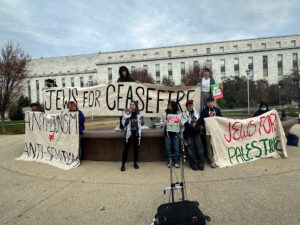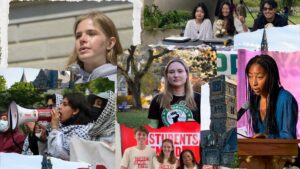The day I graduated high school, I opened Instagram to find a picture of myself, donning cap and gown, on the school system’s story. I was elated to have my five seconds of fame, and it wouldn’t be the last time something like this happened. Throughout my time at Georgetown so far, I have found my picture in newsletters for clubs and campus events on several occasions—even for clubs I am not a member of and events I only popped in to for a few minutes. But as fun as it is to have my time in the spotlight, I can’t help but have a more serious thought tug at my mind in instances like this: why me? Among a plethora of students, how do cameras always find my face?
To me, the most obvious answer is that it is because I am a hijabi (or that I am a woman of color—take your pick). I’m a visual representation of communities who aren’t always imagined when one thinks about who occupies the spaces on this campus, or even this country. But my feelings around becoming the “face” of the communities I come from are complicated. On one hand, feeling celebrated is always lovely, even more so knowing that my face shows people that our student body is both ethnically and religiously diverse. However, being a “diversity shot” never sits right with me. At the end of the day, I know that a photo of me, a religious and ethnic minority, may have better PR implications at my Jesuit, predominantly white institution (PWI) than a photo of someone else.
This is true not just for me, but anyone who comes from an underrepresented community on our campus. This is apparent from a Georgetown Instagram post commemorating an academic ceremony in August 2022. The photo focuses on a Sikh student, with the surrounding students blurred by the camera. While it is great to celebrate our campus’s diversity, efforts like this feel overly dramatic to the point where they lose authenticity: they feel shallow and performative.
Sure, Georgetown has done some truly meaningful work, at least in my experience. It was the first American university to appoint a full-time Muslim chaplain and establish a mosque complete with ablution stations and a halal kitchen, and the resources provided by Muslim Life heavily influenced my college decision. But at the end of the day, the attention Georgetown gives to these religious and ethnic minorities on social media is not reflective of the attention it gives them with policy and action. In reality, Georgetown has a tendency to act for these minority communities only in response to student mobilization.
Most prominently, we can look at the example of last year’s GU Protects Racists sit-ins. These demonstrations fought to elicit a university response to the demands of LaHannah Giles (CAS ’23), who survived an on-campus hate crime in April 2022. University administration only addressed the demands brought by Giles and other student activists after weeks of student protests and advocacy, and even then, its response fell short. The Georgetown Reconciliation Fund, which provides funding for community-based projects that benefit descendant communities of those once enslaved on the Maryland Jesuit plantations, was only established after a student referendum in 2019. Georgetown’s new South Asian Studies certificate program came only after a large push from the student body, largely through the leadership of Georgetown’s South Asian Society. The construction of Georgetown’s Dharmālaya, a meditation space for adherents of Dharmic spiritual traditions, was only realized after years of student advocacy and alumni efforts.
This final example illustrates the performative nature of Georgetown’s media representation of religious minorities. How much authenticity does a post highlighting a Sikh student have when the university cannot provide for their community on its own accord, relying instead on cues from students to act?
Georgetown’s habit of celebrating student diversity online, while failing to actually invest in this diversity in reality, is emblematic of tokenism. Tokenism refers to the inclusion of individuals from minority backgrounds in an attempt to create an image that everyone within an institution is treated fairly. When institutions engage in tokenism, they welcome individuals of minority background into their space, but fail to properly meet their unique needs or recognize their potential for unique contributions. By highlighting students with underrepresented identities on social media, Georgetown essentially creates a utopic image of its campus life that is detached from the true experiences of these same communities who lack administrative support and investment.
After looking through Georgetown’s Instagram page, a potential student may envision hundreds of students sharing an ethnic or religious background with them and constant support from university administration. They may happily bring this perception with them upon their arrival to campus, only to find themselves the only person of color in their class and reliant on student initiatives for improved resources for their community. This can result in shocking isolation when students join the campus community and are forcefully thrown into real life at a PWI. The anticipated support for minority communities is met with the harsh reality of students forced to compensate for gaps in university resources. Rather than providing for minority communities on campus proactively, Georgetown tends to let their needs fly under the radar until they are forcefully brought to the forefront by student initiatives. Yet even their retroactive support is often lackluster and disappointing.
It is always important to showcase the rich diversity of Georgetown’s student body, but doing so should be accompanied by equally enthusiastic investment in underrepresented communities—otherwise, we cross the line from representation into tokenism. Real, tangible action that increases resources for these communities will always be more important than an Instagram post. In the same way, the people of these communities—their stories, voices, and opinions—will always be worth more than just a mere photo of them. Their status as Hoyas is worth infinitely more than clickbait—it is an irreplaceable contribution to the Hilltop.





